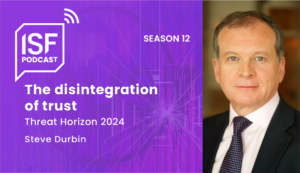Organisations Cannot Prosper Without Trust: Five ways to boost trust with cyber security
Trust is at the heart of every business relationship. Consumers won’t do business with you and employees won’t work with you if they don’t trust you. And while trust can comprise a number of elements (including product quality, honesty, integrity and goodwill), security is quickly emerging as one of the key pillars of trust. Per a recent PwC survey, consumers, employees and business leaders agree that data protection and cyber security are the number one foundational elements of trust.
As issues surrounding data security, privacy, breaches, espionage and misinformation come to the forefront, businesses are at an increased risk of losing both their revenue and reputation. According to Deloitte, a negative trust-related event can erode an enterprise’s market cap by 20% to 56% and has the potential to trigger a chain reaction of events that can result in an adverse reputational impact. What’s worse, given the speed at which information is made available and spread on social media, it can be nearly impossible for businesses to prevent the dilution of enterprise value and trust in the eyes of their stakeholders.
Conversely, cyber security is also an opportunity in disguise. Consumers tend to trust companies that limit the use of personal data and respond swiftly to hacks and breaches. Following these practices can help you create a positive impact on loyalty, revenue growth, brand value and employee retention. So, how can your organisation use cyber security to boost trust and confidence? Here are five recommendations:
1. Assess trust levels in your organisation
Conduct a baseline assessment of the expectations that exist in the eyes of various stakeholders (including customers, investors, suppliers and employees) from the point of view of cyber security and trust. Find out if they understand the cyber security strategy that is in place and if they feel that controls are adequate. See whether they trust the organisation, its leaders and the overall strategy from a cyber security perspective.
Be mindful of how various groups can have different levels of expectations and priorities. Try to benchmark your findings against industry leaders so that you can evaluate your trust-related performance. Next, identify critical gaps in expectations and areas of weaknesses in order to create your overall strategy and timeline to address the issues you have uncovered.
2. Back up your strategy with the right cyber security investments
A strategy without the right amount of investment can lead to suboptimal results. Estimate the amount of investment needed based on the issues identified, the industry you’re in, the profile of your customers and the sensitivity of the data you are managing. It’s probably not feasible to address all trust gaps in one go, and therefore, it is always a good idea to prioritise your focus areas based on drivers of trust and the cyber security priorities of your organisation. Don’t treat cyber security as a cost centre, but instead, consider it as an investment and opportunity to build trust with your stakeholders.
3. Weave cyber security and trust into people
It’s impossible to win trust externally unless you have trust internally. That’s why it’s important to develop a trust-first culture where employees put cyber security at the centre of everything they do. There are two crucial elements to this: transparency and training. Transparency means having clear and demonstrable processes that provide complete clarity to stakeholders on what you do, why you do it and how you do it. It also means being ethical about your practices and being honest about the risks the organisation faces.
Businesses must ensure that employees operate with a high degree of security hygiene—strong passwords, phishing awareness, multifactor authentication, regular patching, etc. In the end, employees should feel more confident about the cyber security approach of the organisation and also understand the long-term value of cyber security and privacy as well as its impact on the business.
4. Never take cyber security and trust for granted
The threat landscape is continuously evolving. As new devices, applications, users and other infrastructure get thrown into the mix, cyber security becomes even more complex. Organisations must therefore have a repeatable, measurable process in place that ensures they do not become complacent or overconfident with their security posture. Remember that it takes just one lapse in judgment, one cyber incident, to wash away all the trust you have built over time.
5. Put trust at the heart of cyber security
Business has always been about trust: buyers trusting sellers, employees trusting employers, businesses trusting partners. Consumers trust organisations with their valuable data; therefore, it’s the organisation’s responsibility to ensure it abides by that trust. This means designing products and services that are secure by design, making leadership and employees accountable for security, assessing cyber risks on a regular basis, committing to sharing information about vulnerabilities or attacks and having timely and well-rehearsed processes in place to mitigate the impact of cyber incidents.
Trust is not built overnight. It takes time and repeated assurances. Organisations should realise that cyber security is now a cornerstone of trust between them and the consumer. Now more than ever, organisations must weave cyber security into everything they do. Without doing so, everything will invariably come crashing down.



